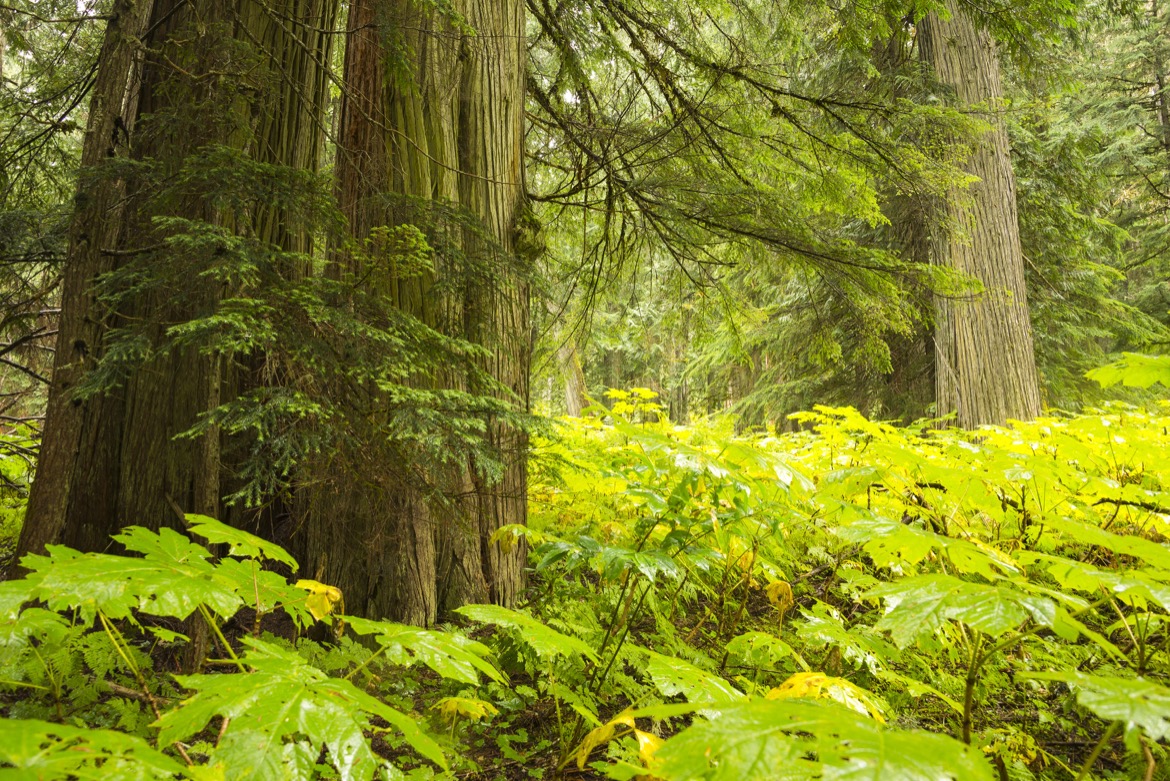PLANT COMMUNITIES
The nature of any plant community found in a given area is the product of the specific environmental conditions found there. The mosaic of diverse climatic conditions found in the West Kootenay produced an equally diverse range of plant communities. The region is a botanist’s dream.
Ecologists classify plant communities as belonging to specific “biogeoclimatic zones”, a term referring to the combination of climate, soil type and plant species that interact to produce a characteristic plant community. Four biogeoclimatic zones are represented in the West Kootenay.
1. Interior Western Hemlock Zone
Frequently called the Interior Wet Belt, this plant community thrives at the lower elevation of the northern two-thirds of the region, where the high peaks have squeezed abundant moisture from the clouds. Here, the heavy winter snowfalls and warm summers have produced impressive mature forests. Western hemlock, western red cedar, grand fir, Douglas-fir, western white pine and western yew are common, while on the forest floor, ferns, devil’s club and moss predominate. Flowers include queen’s cup, trillium, wild ginger, spotted coral root and calypso orchid, to name but a few.
In the drier southern parts of the region, we find a transitional forest of the Interior Western Hemlock zone. There is a tremendous variety of tree species in this zone, with one, the western larch, being characteristic. An unusual feature of this conifer is displayed each fall when its needles turn golden and are shed.
2. Interior Douglas-For Zone
This forest community, found in drier areas, is represented at lower elevations in the southwest Selkirks. Here, mature forests are relatively open, allowing for more abundant growth of shrubs and small trees. Characteristic trees include Douglas-fir, lodgepole pine and trembling aspen. Common shrubs are False Box, kinnikinnick, soopolallie and Oregon Grape.
In certain areas, mostly dry, sunny slopes, the Interior Douglas-fir zone resembles the more arid Ponderosa Pine-Bunchgrass zone. Characterized by open, grassy hillsides dotted with ponderosa pines, this distinctive plant community is best represented around Deer Park, north of Castlegar.
An excellent example of the Interior Douglas-Fir community at its wettest is Champion Lakes Provincial Park, located above Trail. Here, the zone mingles with the Interior Western Hemlock forest to produce a tremendously diverse transitional community, with twelve species of conifers occurring at the same elevations.
3. Engelman Spruce-Subalpine Fir Zone
This plant community generally prevails everywhere in the region at elevations of between 1524m and 2286m (5000 to 7500 ft). Only plants that can tolerate long winters and short summer growing seasons survive here. The Engelman spruce and the subalpine fir are shaped for survival; their conical form is ideal for preventing heavy buildups of potentially dangerous snow.
Mature stands of this forest are generally well-spaced, allowing for the luxuriant growth of low shrubs and flowers. At high elevations near timberline, the forest openings in summer are vibrant flower gardens. Common shrubs are blue and lack mountain huckleberries, white rhododendrons, mountain ash and twinberry. Flowers include red and yellow monkeyflowers, arnica, Indian paintbrush, mountain valerian and monkshood.
4. Alpine Tundra Zone
The land above the timberline is designated alpine tundra, but timberline is not a definitive term. High above the forested slopes, trees such as subalpine fir, whitebark pine, and Lyall’s larch survive; in sheltered pockets, though dwarfed, they retain their tree shapes, whereas on more exposed sites they become Krummholz – dense, low-lying forms that hug the earth like blankets.
To appreciate the hardships of life in the alpine zone, one needs only look at the twisted and contorted forms of these tangled old dwarfs, surviving here against all odds. They symbolize life in the alpine: fragile, yet tenacious. And when you visit this delicate area, be especially considerate, for damage done here may take hundreds of years to repair.
In summer, the meadows come alive with colour and scent. The heavy snows of winter, which have locked up life for ten months, melt to provide ample moisture, and the shrubs and flowers, free from a shading forest canopy, are drenched with intense sunlight. Life explodes.
Time is the key. Within the few weeks of an alpine summer, a plant must flower, reproduce and store food for the future. Most species, like the western anemone, are geared for this race. Using stored food energy from its tuberous rootstock, it pushes its bloom through the still-melting snow. For frost and moisture protection, the anemone has an insulating covering of fine hairs, and its bloom, in the shape of a parabolic disc, collects the sun’s rays to warm its developing ovaries.
Insects are as vital to the survival of plants as they are. In their rush to live a year in a month, both alpine flowers and the insects that feed upon them conduct an intense struggle for survival, the insects competing with one another for plant food sources, and the plants, with the lure of colour and scent, competing for pollinating insects. The vivid colours, heady fragrances and steady humming sounds of an alpine meadow are testimony to this dramatic urgency.
The alpine community in the West Kootenay is blessed with an abundance of plant species. Many field guides are available to help you identify and enjoy the flora here, and I recommend carrying one when you visit the sensational floral displays found in summer above the timber line.
THE WORLD’S ONLY INLAND TEMPERATE RAINFOREST

